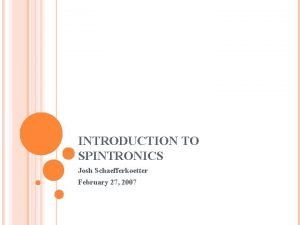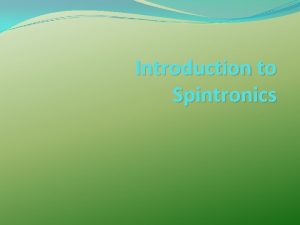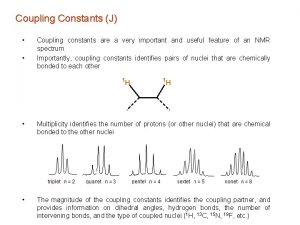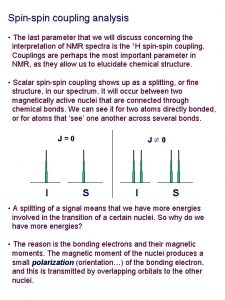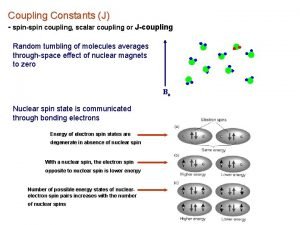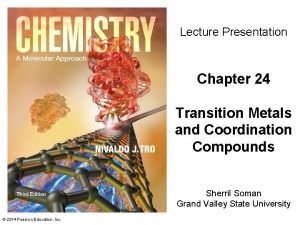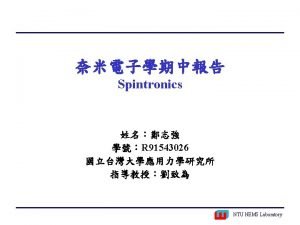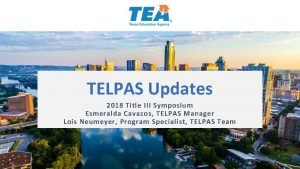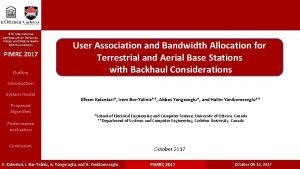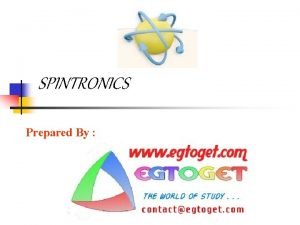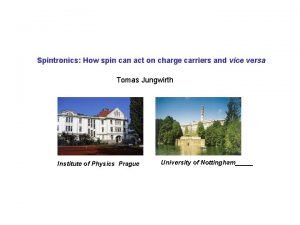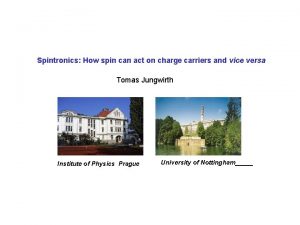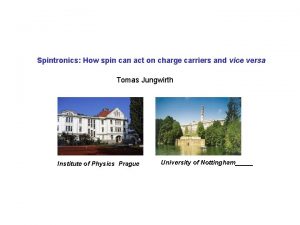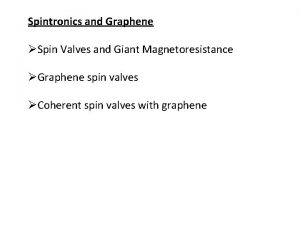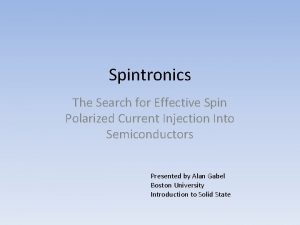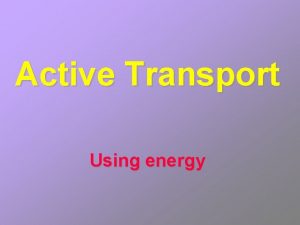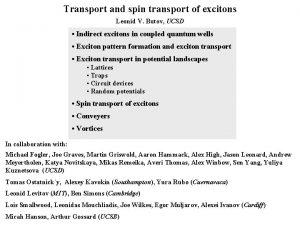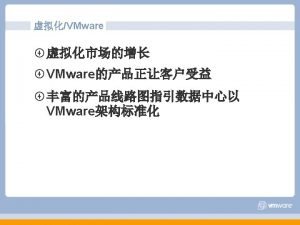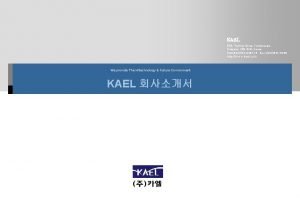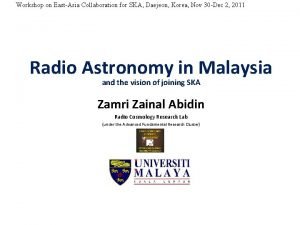CavendishKAIST Symposium Spintronics Daejeon 2006 Spin transport using


















- Slides: 18

Cavendish-KAIST Symposium, Spintronics, Daejeon 2006 Spin transport using optically injected spin electrons W. S. Cho and J. A. C. Bland Cavendish Laboratory, University of Cambridge, UK Thin Film Magnetism Group, Cavendish Laboratory, University of Cambridge

Materials Challenges for Spintronic Devices Dilute Magnetic SC FM metals Advantages: No conductivity mismatch, high spin injection efficiency has been demonstrated Advantages: well-known Materials, operation at room temperature and low magnetic fields possible, low resistance Drawbacks: Low Curie temperatures and/or high magnetic fields required Y. Ohno et al. , Nature, 402, 790 (1999) R. Fiederling et al. , Nature, 402, 787 (1999) Drawbacks: Spin injection and detection efficiencies observed so far are small B. T. Jonker and M. E. Flatté in Nanomagnetism: Ultrathin Films, Multilayers and Nanostructures, edited by D. L. Mills and J. A. C. Bland, Elsevier, Amsterdam (2006)

Critical Issues in Hybrid FM Metal/SC Structures 1. Can the electron spin be preserved upon transport across the FM/SC interface at RT. ? 2. How important are the details (morphology, composition, defects, etc) of the interface structure? Direct Interface Tunnel Barrier Interface 3. Can FM metals act as efficient spin injectors/detectors (conductivity mismatch)? J. A. C. Bland et al. in Ultrathin Magnetic Structures IV: Applications of Nanomagnetism, Verlag, Berlin (2005); E. I. Rashba, Phys. Rev. B 62, R 16267 (2000) Springer

Electrical spin injection and optical detection Spin LED Schottky Barrier Injected electron spin polarisation S is determined from the circular polarisation of the electroluminescent light Artificial Tunnel Barrier S ~ 2% for Fe/Ga. As at RT S ~ 9% for Co. Fe/Al. Ox/Al. Ga. As at 80 K H. J. Zhu et al. , Phys. Rev. Lett. 87, 016601 (2001) V. F. Motsnyi et al. , Appl. Phys. Lett. 81, 265 (2002) S ~ 32% for Fe/Al. Ga. As at 4. 5 K S ~ 55% for Co. Fe/Mg. O/Al. Ga. As at 100 K A. T. Hanbicki et al. , Appl. Phys. Lett. 82, 4092 (2003) R. Wang et al. , Appl. Phys. Lett. 86, 052901 (2005)

Optical Spin injection using circularly polarized light mj -1/2 +1/2 S 1/2 h 1 1 3 3 Eg = 1. 43 e. V s+ s 2 hh mj 2 lh lh -3/2 -1/2 hh +1/2 +3/2 +1/2 P 3/2 P 1/2 = 0. 34 e. V The transition selection rule mj = ± 1 For h > Eg + , P decreases due to the mixture of P 3/2 states with P 1/2 states, which have an opposite sign of polarization to P 3/2 states. Although the maximum polarization is expected to be 50% in theory, the maximum is experimentally observed to be ~40% at the threshold. D. T. Pierce et al. Phys. Rev. B, 13, 5484 (1976)

Identifying the True Spin Filtering Signal in FM/Ga. As Schottky Barrier Structures Ni. Fe 5. 0 nm True spin filtering signal ISF = I - Iph Bias and Ga. As doping density dependence of ISF suggest that electron tunneling is the relevant spin dependent transport process S. J. Steinmuller et al. , Phys. Rev. B 72, 045301 (2005)

Future works FM Insulator (Al. Ox / Mg. O) Study of tunneling polarisation through optical injection - High efficiency of spin-polarised electron transport into the MTJ structure; systematic investigation of tunneling process & relaxation mechanism - Observation of Quantum-Well states in FM layer Ga. As / In. P S. Van Dijken et al. Phys. Rev. Lett. 90 197203 (2003) T. Nozaki et al. Phys. Rev. Lett. 96, 027208 (2006) FM NM Insulator (Al. Ox / Mg. O) FM Insulator (Al. Ox / Mg. O) Ga. As / In. P Resonant tunneling through optical injection - Quantum oscillation along the voltage change - Comparison (QW in FM & NM layer) Z. M. Zeng et al. Phys. Rev. Lett. 97, 106605 (2006) J. Mathon et al, Phys. Rev. B 71, 220402(R) (2005) S. Yuasa et al. Science 297 145 (2002)

Future works Direct measurement of true spin filtered current in window type samples - True spin filtered photocurrents from window type sample; estimate of MCD factor, real spin device

Cavendish-KAIST Symposium, Spintronics, Daejeon 2006 Room temperature spin detection in ferromagnetic metal/Al 2 O 3/Ga. As heterostructures W. S. Cho, K. Y. Lee, S. J. Steinmuller, T. Trypiniotis and J. A. C. Bland Cavendish Laboratory, University of Cambridge, UK K. H. Shin KIST, Korea Thin Film Magnetism Group, Cavendish Laboratory, University of Cambridge

Transport mechanism of in Hybrid FM/SC Structures ITE i+ ∆I=p(i+-i-) IT ID i- IHD ID : Transport of photoexcited electrons into bulk semiconductor IT : Quantum mechanical tunneling of electrons ITE : Thermionic emission/Ballistic transport IHD : Electron transport beneath Fermi level Different charge transport mechanisms contribute to the net measured photocurrent, depending on the applied bias Magnetic circular dichroism (MCD) in the FM layer could obscure or even mimic any real spin filtering effect

Spin Polarized Electron Transmission in Schottky vs Artificial Tunnel Barrier Structures FM n-type SC FM V≥ 0 FM p-type SC FM

The Tunnel device of Ni. Fe/Al 2 O 3/p-type. Ga. As Structure He-Ne laser energy: 1. 96 e. V Energy gap of Ga. As: 1. 43 e. V Tunnel barrier height: ~1. 2 e. V Micro-fabrication process Well defined interface control and high efficient spin transport

Optical Spin Injection and Electrical Detection Set Up

Interface characteristics in Ni. Fe/Al 2 O 3/p-type Ga. As Structures Tunneling process Thermionic emission Well defined interface due to Al 2 O 3 tunnel barrier The contribution of the electron and hole current generated by photoexcitation The electron transport mechanism change from tunneling process to thermionic emission with applied forward bias (with respect to Ni. Fe layer)

Spin filtering in Ni. Fe/Al 2 O 3/p-type Ga. As Structures ∆I = p(i+-i-) under circularly polarized light I is proportional to the magnetisation of Ni. Fe layer Saturated ∆I due to thermionic emission under high applied forward bias. MCD contribution

Evaluation of MCD and True Spin filtering in Ni. Fe/Al 2 O 3/p-type Ga. As Structures ISF = I - IMCD = Iph 4 6 ISF peak heights around 0. 55 V due to the optimised electron tunneling process. MCD factor and ISF curves reveal that tunneling effect is strongly dependent on the magnetisation of Ni. Fe layer. the obstacle to develop a real spin device 4

Summary and Outlook Spin filtering of electrons transmitted across the Ni. Fe/Al 2 O 3/p-type Ga. As interface is observed at forward bias at room temperature Only tunneling electrons show significant spin dependent transmission as in earlier experiments on n-type Ga. As in the structure based on ptype Ga. As the depletion region should be modulated to realize high efficiency of spin tunneling. Critical issues for the exploitation of the observed effect in spintronic devices are a deeper understanding of the underlying theory control of the FM/SC interface properties (incl. barrier layer) optimisation of the details of the SC structure new structure to exclude MCD from measured helicity dependent photocurrent

Spin Filtering in FM/Al. Ga. As Barrier/Ga. As Structures 6. 0 0. 0 = 0. 112% Peff = 0. 019% 6. 0 i+ i- I (n. A) 0. 0 = 0. 149% Peff = 0. 070% 6. 0 0. 0 = 0. 171% Peff = 0. 086% 6. 0 i + & i - due to the spin split DOS in the FM 0. 0 = 0. 185% Peff = 0. 107% 0. 4 0. 5 0. 6 Bias (V) 0. 7 Electron tunneling is the spin dependent transport process at the FM/Ga. As interface 0. 8 S. E. Andresen et al. , Phys. Rev. B 68, 073303 (2003)
 Introduction to spintronics
Introduction to spintronics Introduction to spintronics
Introduction to spintronics Coupling constant nmr
Coupling constant nmr Spin spin coupling
Spin spin coupling Spin spin coupling
Spin spin coupling Low spin and high spin complex
Low spin and high spin complex Spin down
Spin down Passive transport vs active transport venn diagram
Passive transport vs active transport venn diagram Bioflix activity membrane transport diffusion
Bioflix activity membrane transport diffusion Active transport image
Active transport image Sodium potasium pump
Sodium potasium pump Pinocytosis vs phagocytosis
Pinocytosis vs phagocytosis Primary vs secondary active transport
Primary vs secondary active transport Primary active transport vs secondary active transport
Primary active transport vs secondary active transport Now answer the questions
Now answer the questions Bioflix activity membrane transport active transport
Bioflix activity membrane transport active transport Telpas speaking rubric
Telpas speaking rubric Symposium
Symposium Florida hazmat symposium
Florida hazmat symposium
